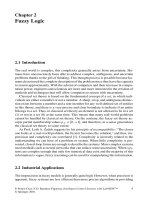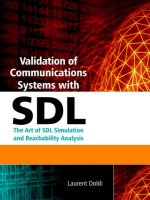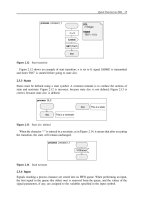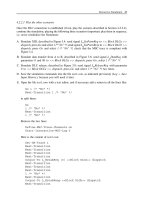fast data processing systems with smack stack
Bạn đang xem bản rút gọn của tài liệu. Xem và tải ngay bản đầy đủ của tài liệu tại đây (10.32 MB, 370 trang )
Fast Data Processing Systems
with SMACK Stack
Combine the incredible powers of Spark, Mesos, Akka,
Cassandra, and Kafka to build data processing platforms that
can take on even the hardest of your data troubles!
Raúl Estrada
BIRMINGHAM - MUMBAI
Fast Data Processing Systems with SMACK
Stack
Copyright © 2016 Packt Publishing
All rights reserved. No part of this book may be reproduced, stored in a retrieval system, or
transmitted in any form or by any means, without the prior written permission of the
publisher, except in the case of brief quotations embedded in critical articles or reviews.
Every effort has been made in the preparation of this book to ensure the accuracy of the
information presented. However, the information contained in this book is sold without
warranty, either express or implied. Neither the author, nor Packt Publishing, and its
dealers and distributors will be held liable for any damages caused or alleged to be caused
directly or indirectly by this book.
Packt Publishing has endeavored to provide trademark information about all of the
companies and products mentioned in this book by the appropriate use of capitals.
However, Packt Publishing cannot guarantee the accuracy of this information.
Production reference: 1151216
Published by Packt Publishing Ltd.
Livery Place
35 Livery Street
Birmingham
B3 2PB, UK.
ISBN 978-1-78646-720-1
www.packtpub.com
Credits
Author
Copy Editor
Raúl Estrada
Safis Editing
Reviewers
Project Coordinator
Anton Kirillov
Sumit Pal
Shweta H Birwatkar
Commissioning Editor
Proofreader
Veena Pagare
Safis Editing
Acquisition Editor
Indexer
Divya Poojari
Mariammal Chettiyar
Content Development Editor
Graphics
Amrita Noronha
Disha Haria
Technical Editor
Production Coordinator
Sneha Hanchate
Nilesh Mohite
About the Author
Raúl Estrada is a programmer since 1996 and Java Developer since 2001. He loves
functional languages such as Scala, Elixir, Clojure, and Haskell. He also loves all the topics
related to Computer Science. With more than 12 years of experience in High Availability
and Enterprise Software, he has designed and implemented architectures since 2003.
His specialization is in systems integration and has participated in projects mainly related
to the financial sector. He has been an enterprise architect for BEA Systems and Oracle Inc.,
but he also enjoys Mobile Programming and Game Development. He considers himself a
programmer before an architect, engineer, or developer.
He is also a Crossfitter in San Francisco, Bay Area, now focused on Open Source projects
related to Data Pipelining such as Apache Flink, Apache Kafka, and Apache Beam. Raul is a
supporter of free software, and enjoys to experiment with new technologies, frameworks,
languages, and methods.
I want to thank my family, especially my mom for her patience and dedication.
I would like to thank Master Gerardo Borbolla and his family for the support and feedback they
provided on this book writing.
I want to say thanks to the acquisition editor, Divya Poojari, who believed in this project since the
beginning.
I also thank my editors Deepti Thore and Amrita Noronha. Without their effort and patience, it
would not have been possible to write this book.
And finally, I want to thank all the heroes who contribute (often anonymously and without profit)
with the Open Source projects specifically: Spark, Mesos, Akka, Cassandra, and Kafka; an honorable
mention for those who build the connectors of these technologies.
About the Reviewers
Anton Kirillov started his career as a Java developer in 2007, working on his PhD thesis in
the Semantic Search domain at the same time. After finishing and defending his thesis, he
switched to Scala ecosystem and distributed systems development. He worked for and
consulted startups focused on Big Data analytics in various domains (real-time bidding,
telecom, B2B advertising, and social networks) in which his main responsibilities were
focused on designing data platform architectures and further performance and stability
validation. Besides helping startups, he has worked in the bank industry building
Hadoop/Spark data analytics solutions and in a mobile games company where he has
designed and implemented several reporting systems and a backend for a massive parallel
online game.
The main technologies that Anton has been using for the recent years include Scala,
Hadoop, Spark, Mesos, Akka, Cassandra, and Kafka and there are a number of systems he’s
built from scratch and successfully released using these technologies. Currently, Anton is
working as a Staff Engineer in Ooyala Data Team with focus on fault-tolerant fast analytical
solutions for the ad serving/reporting domain.
Sumit Pal has more than 24 years of experience in the Software Industry,
spanning companies from startups to enterprises. He is a big data architect, visualization
and data science consultant, and builds end-to-end data-driven analytic systems. Sumit has
worked for Microsoft (SQLServer), Oracle (OLAP), and Verizon (Big Data Analytics).
Currently, he works for multiple clients building their data architectures and big data
solutions and works with Spark, Scala, Java, and Python. He has extensive experience in
building scalable systems in middletier, datatier to visualization for analytics applications,
using BigData and NoSQL DB. Sumit has expertise in DataBase Internals, Data Warehouses,
Dimensional Modeling, As an Associate Director for Big Data at Verizon, Sumit,
strategized, managed, architected and developed analytic platforms for machine learning
applications. Sumit was the Chief Architect at ModelN/LeapfrogRX (2006-2013), where he
architected the core Analytics Platform.
Sumit has recently authored a book with Apress - called - "SQL On Big Data - Technology,
Architecture and Roadmap". Sumit regularly speaks on the above topic in Big Data
Conferences across USA.
Sumit has hiked to Mt. Everest Base Camp at 18.2K feet in Oct, 2016. Sumit is also an avid
Badminton player and has won a bronze medal in 2015 in Connecticut Open in USA in the
men's single category.
www.PacktPub.com
For support files and downloads related to your book, please visit www.PacktPub.com.
Did you know that Packt offers eBook versions of every book published, with PDF and
ePub files available? You can upgrade to the eBook version at www.PacktPub.com and as a
print book customer, you are entitled to a discount on the eBook copy. Get in touch with us
at for more details.
At www.PacktPub.com, you can also read a collection of free technical articles, sign up for a
range of free newsletters and receive exclusive discounts and offers on Packt books and
eBooks.
/>
Get the most in-demand software skills with Mapt. Mapt gives you full access to all Packt
books and video courses, as well as industry-leading tools to help you plan your personal
development and advance your career.
Why subscribe?
Fully searchable across every book published by Packt
Copy and paste, print, and bookmark content
On demand and accessible via a web browser
Table of Contents
Preface
Chapter 1: An Introduction to SMACK
Modern data-processing challenges
The data-processing pipeline architecture
The NoETL manifesto
Lambda architecture
Hadoop
SMACK technologies
Apache Spark
Akka
Apache Cassandra
Apache Kafka
Apache Mesos
Changing the data center operations
From scale-up to scale-out
The open-source predominance
Data store diversification
Data gravity and data locality
DevOps rules
Data expert profiles
Data architects
Data engineers
Data analysts
Data scientists
Is SMACK for me?
Summary
1
7
8
10
11
12
12
13
14
15
16
17
17
18
18
18
18
19
19
19
20
20
21
21
22
22
Chapter 2: The Model - Scala and Akka
23
The language – Scala
Kata 1 – The collections hierarchy
25
26
27
28
29
30
30
Sequence
Map
Set
Kata 2 – Choosing the right collection
Sequence
Map
Set
Kata 3 – Iterating with foreach
Kata 4 – Iterating with for
Kata 5 – Iterators
Kata 6 – Transforming with map
Kata 7 – Flattening
Kata 8 – Filtering
Kata 9 – Subsequences
Kata 10 – Splitting
Kata 11 – Extracting unique elements
Kata 12 – Merging
Kata 13 – Lazy views
Kata 14 – Sorting
Kata 15 – Streams
Kata 16 – Arrays
Kata 17 – ArrayBuffer
Kata 18 – Queues
Kata 19 – Stacks
Kata 20 – Ranges
The model – Akka
The Actor Model in a nutshell
Kata 21 – Actors
The actor system
Actor reference
Kata 22 – Actor communication
Kata 23 – Actor life cycle
Kata 24 – Starting actors
Kata 25 – Stopping actors
Kata 26 – Killing actors
Kata 27 – Shutting down the actor system
Kata 28 – Actor monitoring
Kata 29 – Looking up actors
Summary
Chapter 3: The Engine - Apache Spark
Spark in single mode
Downloading Apache Spark
Testing Apache Spark
Spark core concepts
32
33
34
35
36
37
38
39
39
41
42
42
43
45
46
47
48
48
50
51
52
54
55
57
57
58
60
62
64
67
68
69
70
70
71
71
72
73
74
[ ii ]
Resilient distributed datasets
Running Spark applications
Initializing the Spark context
Spark applications
Running programs
RDD operation
Transformations
Actions
Persistence (caching)
Spark in cluster mode
Runtime architecture
Driver
Dividing a program into tasks
Scheduling tasks on executors
Executor
Cluster manager
Program execution
Application deployment
Standalone cluster manager
Launching the standalone manager
Submitting our application
Configuring resources
Working in the cluster
Spark Streaming
Spark Streaming architecture
Transformations
Stateless transformations
Stateful transformations
Windowed operations
Update state by key
Output operations
Fault-tolerant Spark Streaming
Checkpointing
Spark Streaming performance
Parallelism level
Window size and batch size
Garbage collector
Summary
Chapter 4: The Storage - Apache Cassandra
A bit of history
NoSQL
NoSQL or SQL?
75
76
77
77
78
79
79
84
86
87
88
89
90
90
91
92
92
93
95
95
97
97
99
99
99
102
102
104
104
106
107
107
108
108
108
109
109
110
111
111
112
114
[ iii ]
CAP Brewer's theorem
Apache Cassandra installation
Data model
Data storage
Installation
DataStax OpsCenter
Creating a key space
Authentication and authorization (roles)
Setting up a simple authentication and authorization
Backup
Compression
Recovery
Restart node
Printing schema
Logs
Configuring log4j
Log file rotation
User activity log
Transaction log
SQL dump
CQL
CQL commands
DBMS Cluster
Deleting the database
CLI delete commands
CQL shell delete commands
DB and DBMS optimization
Bloom filter
Data cache
Java heap tune up
Java garbage collection tune up
Views, triggers, and stored procedures
Client-server architecture
Drivers
Spark-Cassandra connector
Installing the connector
Establishing the connection
Using the connector
Summary
Chapter 5: The Broker - Apache Kafka
[ iv ]
114
116
116
118
119
121
122
124
124
125
126
127
127
128
128
128
129
130
130
130
131
132
133
137
137
137
138
141
142
144
144
144
145
146
146
146
147
149
150
151
Introducing Kafka
Features of Apache Kafka
Born to be fast data
Use cases
Installation
Installing Java
Installing Kafka
Importing Kafka
Cluster
Single node – single broker cluster
Starting Zookeeper
Starting the broker
Creating a topic
Starting a producer
Starting a consumer
Single node – Multiple broker cluster
Starting the brokers
Creating a topic
Starting a producer
Starting a consumer
Multiple node – multiple broker cluster
Broker properties
Architecture
Segment files
Offset
Leaders
Groups
Log compaction
Kafka design
Message compression
Replication
Asynchronous replication
Synchronous replication
Producers
Producer API
Scala producers
Step 1: Import classes
Step 2: Define properties
Step 3: Build and send the message
Step 4: Create the topic
Step 5: Compile the producer
Step 6: Run the producer
Step 7: Run a consumer
[v]
152
152
154
155
157
158
158
159
159
160
161
162
163
163
164
165
166
167
167
167
168
169
170
172
172
173
173
173
174
174
175
176
176
177
177
177
177
178
178
180
180
180
180
Producers with custom partitioning
Integration
Integration with Apache Spark
Administration
Cluster tools
Adding servers
Kafka topic tools
Cluster mirroring
Summary
180
181
181
181
183
183
184
184
184
184
185
186
186
186
187
187
188
188
189
189
189
189
189
190
192
192
192
192
193
194
194
195
195
197
199
200
201
Chapter 6: The Manager - Apache Mesos
202
Step 1: Import classes
Step 2: Define properties
Step 3: Implement the partitioner class
Step 4: Build and send the message
Step 5: Create the topic
Step 6: Compile the programs
Step 7: Run the producer
Step 8: Run a consumer
Producer properties
Consumers
Consumer API
Simple Scala consumers
Step 1: Import classes
Step 2: Define properties
Step 3: Code the SimpleConsumer
Step 4: Create the topic
Step 5: Compile the program
Step 6: Run the producer
Step 7: Run the consumer
Multithread Scala consumers
Step 1: Import classes
Step 2: Define properties
Step 3: Code the MultiThreadConsumer
Step 4: Create the topic
Step 5: Compile the program
Step 6: Run the producer
Step 7: Run the consumer
Consumer properties
The Apache Mesos architecture
Frameworks
Existing Mesos frameworks
Frameworks for long running applications
Frameworks for scheduling
[ vi ]
202
204
205
205
205
Frameworks for storage
Attributes and resources
Attributes
Resources
The Apache Mesos API
Messages
The Executor API
Executor Driver API
The Scheduler API
The Scheduler Driver API
Resource allocation
The DRF algorithm
Weighted DRF algorithm
Resource configuration
Resource reservation
Static reservation
Defining roles
Assigning frameworks to roles
Setting policies
Dynamic reservation
The reserve operation
The unreserve operation
HTTP reserve
HTTP unreserve
Running a Mesos cluster on AWS
AWS instance types
AWS instances launching
Installing Mesos on AWS
Downloading Mesos
Building Mesos
Launching several instances
Running a Mesos cluster on a private data center
Mesos installation
Setting up the environment
Start the master
Start the slaves
Process automation
Common Mesos issues
Missing library dependencies
Directory permissions
Missing library
Debugging
Directory structure
Slaves not connecting with masters
Multiple slaves on the same machine
[ vii ]
206
206
206
206
207
208
208
209
210
212
214
215
218
220
221
221
221
222
222
223
223
225
226
227
228
229
229
230
231
232
233
234
234
235
236
237
237
238
238
239
239
239
240
240
240
Scheduling and management frameworks
Marathon
Apache Spark on Apache Mesos
Submitting jobs in client mode
Submitting jobs in cluster mode
Advanced configuration
Apache Cassandra on Apache Mesos
Advanced configuration
Apache Kafka on Apache Mesos
Kafka log management
Summary
241
242
242
243
243
244
245
245
245
245
246
246
247
247
247
248
248
249
249
249
249
250
251
251
252
253
254
254
255
257
257
258
259
259
261
262
266
266
Chapter 7: Study Case 1 - Spark and Cassandra
267
Marathon installation
Installing Apache Zookeeper
Running Marathon in local mode
Multi-node Marathon installation
Running a test application from the web UI
Application scaling
Terminating the application
Chronos
Chronos installation
Job scheduling
Chronos and Marathon
Chronos REST API
Listing running jobs
Starting a job manually
Adding a job
Deleting a job
Deleting all the job tasks
Marathon REST API
Listing the running applications
Adding an application
Changing the application configuration
Deleting the application
Apache Aurora
Installing Aurora
Singularity
Singularity installation
The Singularity configuration file
Spark Cassandra connector
Requisites
Preparing Cassandra
SparkContext setup
267
269
270
270
[ viii ]
Cassandra and Spark Streaming
Spark Streaming setup
Cassandra setup
Streaming context creation
Stream creation
Kafka Streams
Akka Streams
Enabling Cassandra
Write the Stream to Cassandra
Read the Stream from Cassandra
Saving datasets to Cassandra
Saving a collection of tuples to Cassandra
Saving collections to Cassandra
Modifying collections
Saving objects of Cassandra (user defined types)
Scala options to Cassandra options conversion
Saving RDDs as new tables
Cluster deployment
Spark Cassandra use cases
Study case: The Calliope project
Installing Calliope
CQL3
Read from Cassandra with CQL3
Write to Cassandra with CQL3
Thrift
Read from Cassandra with Thrift
Write to Cassandra with Thrift
Calliope SQL context creation
Calliope SQL Configuration
Loading Cassandra tables programmatically
Summary
271
271
272
272
272
272
273
273
273
273
274
274
275
276
277
278
279
281
289
290
290
291
291
292
292
292
293
294
294
295
295
Chapter 8: Study Case 2 - Connectors
296
Akka and Cassandra
Writing to Cassandra
Reading from Cassandra
Connecting to Cassandra
Scanning tweets
Testing the scanner
Akka and Spark
Kafka and Akka
Kafka and Cassandra
296
298
299
301
303
304
306
307
311
[ ix ]
Summary
313
Chapter 9: Study Case 3 - Mesos and Docker
Mesos frameworks API
Authentication, authorization, and access control
Framework authentication
Authentication configuration
Framework authorization
Access control lists
Spark Mesos run modes
Coarse-grained
Fine-grained
Apache Mesos API
Scheduler HTTP API
Requests
SUBSCRIBE
TEARDOWN
ACCEPT
DECLINE
REVIVE
KILL
SHUTDOWN
ACKNOWLEDGE
RECONCILE
MESSAGE
REQUEST
Responses
SUBSCRIBED
OFFERS
RESCIND
UPDATE
MESSAGE
FAILURE
ERROR
HEARTBEAT
Mesos containerizers
Containers
Docker containerizers
Containers and containerizers
Types of containerizers
Creating containerizers
Mesos containerizer
Launching Mesos containerizer
Architecture of Mesos containerizer
[x]
314
314
315
315
316
317
317
318
318
319
320
320
320
320
321
321
322
322
323
323
324
324
325
325
325
326
326
326
327
327
328
328
328
329
329
330
333
333
334
335
335
336
Shared filesystem
PID namespace
Posix disk
Docker containerizers
Docker containerizer setup
Launching the Docker containerizers
Composing containerizers
Summary
Index
336
336
337
337
337
338
339
339
340
[ xi ]
Preface
The SMACK stack is a generalized web-scale data pipeline. It was popularized in the San
Francisco Bay Area data engineering meet ups and conferences and spread around the
world. SMACK stands for:
S = Spark: This involves data in-memory distributed computing. Think in Apache
Flink, Apache Ignite, Google Millwheel, and so on.
M = Mesos: This involves Cluster OS, distributed system management,
scheduling and scaling. Think in Apache YARN, Kubernetes, Docker, and so on.
A = Akka: This is the API. It is an implementation of the actor's model. Think in
Scala, Erlang, Elixir, GoLang and so on.
C = Cassandra: This is a persistence layer, noSQL database. Think in Apache
HBase, Riak, Google BigTable, MongoDB, and so on.
K = Kafka: This is a distributed streaming platform, the message broker. Think in
Apache Storm, ActiveMQ, RabbitMQ, Kestrel, JMS, and so on.
During the years 2014, 2015, and 2016, surveys show that among all software developers,
those with higher wages are the data engineers, the data scientists, and the data architects.
This is because there is a huge demand for technical professionals in data and unfortunately
for large organizations and fortunately for developers, there is a very low offer.
If you are reading this book, it is for two reasons: either you want to belong to best paid IT
professionals, or you already belong and you want to learn how today's trends in the not
too distant future will become requirements.
This book explains how to dominate the SMACK stack, which is also called the Spark++,
because it seems to be the open stack that will succeed in the near future.
Preface
What this book covers
Chapter 1, Introducing SMACK, speaks about the fundamental SMACK architecture. We
review the differences between the technologies in SMACK and the traditional data
technologies. We also reviewed every technology in the SMACK and briefly expose each
tool's potential.
Chapter 2, The Model - Scala and Akka, makes it easy by dividing the text into two parts:
Scala (the language) and Akka (the actor model implementation for the JVM). It is a mini
Scala Akka cookbook to learn through several exercises. The first half is for the fundamental
parts of Scala, the second half is focused on the Akka actor model.
Chapter 3, The Engine - Apache Spark, describes the process of setting up a new project with
the help of templates by importing an existing project, serving a web application, and using
File Watchers.
Chapter 4, The Storage - Apache Cassandra, describes using package managers and building
systems for your application by means of WebStorm's built-in features.
Chapter 5, The Broker - Apache Kafka, focuses on the state-of-the-art technologies of the web
industry and describes the process of building a typical application in them using the power
of WebStorm features.
Chapter 6, The Manager - Apache Mesos, shows you how to use JavaScript, HTML, and CSS
to develop a mobile application and how to set up the environment to test run this mobile
application.
Chapter 7, Study case 1 - Spark and Cassandra, shows how to perform the debugging, tracing,
profiling, and code style checking activities directly in WebStorm.
Chapter 8, Study case 2 - Connectors, presents a couple of proven ways to easily perform
application testing in WebStorm using some of the most popular testing libraries.
Chapter 9, Study case 3 - Mesos and Docker, speaks about a second portion of powerful
features provided within WebStorm. In this chapter, we focus on some of WebStorm's
power features that help us boost productivity and developer experience.
What you need for this book
The reader should have some experience in programming (Java or Scala), some experience
in Linux/Unix operating systems and the basics of databases:
For Scala, the reader should know the basics about programming
[2]
Preface
For Spark, the reader should know the fundamentals of Scala Programming
Language
For Mesos, the reader should know the basics of the Operating Systems
administration
For Cassandra, the reader should know the fundamentals of Databases
For Kafka, the reader should have basic knowledge about Scala
Who this book is for
This book is for software developers, data architects, and data engineers looking for how to
integrate the most successful Open Source Data stack architecture and how to choose the
correct technology in every layer and also what are the practical benefits in every case.
There are a lot of books that talk about each technology separately. This book is for people
looking for alternative technologies and practical examples on how to connect the entire
stack.
Conventions
In this book, you will find a number of styles of text that distinguish between different
kinds of information. Here are some examples of these styles, and an explanation of their
meaning.
Code words in text, database table names, folder names, filenames, file extensions,
pathnames, dummy URLs, user input, and Twitter handles are shown as follows: "In the
case of HDFS, we should change the mesos.hdfs.role in the file mesos-site.xml to the
value of role1."
A block of code is set as follows:
[default]
exten => s,1,Dial(Zap/1|30)
exten => s,2,Voicemail(u100)
exten => s,102,Voicemail(b100)
exten => i,1,Voicemail(s0)
[3]
Preface
When we wish to draw your attention to a particular part of a code block, the relevant lines
or items are set in bold:
[default]
exten => s,1,Dial(Zap/1|30)
exten => s,2,Voicemail(u100)
exten => s,102,Voicemail(b100)
exten => i,1,Voicemail(s0)
Any command-line input or output is written as follows:
# cp /usr/src/asterisk-addons/configs/cdr_mysql.conf.sample
/etc/asterisk/cdr_mysql.conf
New terms and important words are shown in bold. Words that you see on the screen, in
menus or dialog boxes for example, appear in the text like this: "clicking the Next button
moves you to the next screen".
Warnings or important notes appear in a box like this.
Tips and tricks appear like this.
Reader feedback
Feedback from our readers is always welcome. Let us know what you think about this
book-what you liked or disliked. Reader feedback is important for us as it helps us develop
titles that you will really get the most out of. To send us general feedback, simply email , and mention the book's title in the subject of your
message. If there is a topic that you have expertise in and you are interested in either
writing or contributing to a book, see our author guide at www.packtpub.com/authors.
[4]
Preface
Customer support
Now that you are the proud owner of a Packt book, we have a number of things to help you
to get the most from your purchase.
Downloading the example code
You can download the example code files for this book from your account at http://www.p
acktpub.com. If you purchased this book elsewhere, you can visit ktpub.c
om/supportand register to have the files e-mailed directly to you.
You can download the code files by following these steps:
1.
2.
3.
4.
5.
6.
7.
Log in or register to our website using your e-mail address and password.
Hover the mouse pointer on the SUPPORT tab at the top.
Click on Code Downloads & Errata.
Enter the name of the book in the Search box.
Select the book for which you're looking to download the code files.
Choose from the drop-down menu where you purchased this book from.
Click on Code Download.
Once the file is downloaded, please make sure that you unzip or extract the folder using the
latest version of:
WinRAR / 7-Zip for Windows
Zipeg / iZip / UnRarX for Mac
7-Zip / PeaZip for Linux
The code bundle for the book is also hosted on GitHub at />ishing/Fast-Data-Processing-Systems-with-SMACK-Stack. We also have other code
bundles from our rich catalog of books and videos available at />Publishing/. Check them out!
[5]
Preface
Downloading the color images of this book
We also provide you with a PDF file that has color images of the screenshots/diagrams used
in this book. The color images will help you better understand the changes in the output.
You can download this file from />loads/FastDataProcessingSystemswithSMACKStack_ColorImages.pdf.
Errata
Although we have taken every care to ensure the accuracy of our content, mistakes do
happen. If you find a mistake in one of our books-maybe a mistake in the text or the codewe would be grateful if you could report this to us. By doing so, you can save other readers
from frustration and help us improve subsequent versions of this book. If you find any
errata, please report them by visiting selecting
your book, clicking on the Errata Submission Form link, and entering the details of your
errata. Once your errata are verified, your submission will be accepted and the errata will
be uploaded to our website or added to any list of existing errata under the Errata section of
that title.
To view the previously submitted errata, go to />t/supportand enter the name of the book in the search field. The required information will
appear under the Errata section.
Piracy
Piracy of copyrighted material on the Internet is an ongoing problem across all media. At
Packt, we take the protection of our copyright and licenses very seriously. If you come
across any illegal copies of our works in any form on the Internet, please provide us with
the location address or website name immediately so that we can pursue a remedy.
Please contact us at with a link to the suspected pirated
material.
We appreciate your help in protecting our authors and our ability to bring you valuable
content.
Questions
If you have a problem with any aspect of this book, you can contact us
at , and we will do our best to address the problem.
[6]









